One of LinkedIn’s primary goals is to aid B2B companies with their marketing strategies by hosting a platform that is strong in business networking and provides tools and subscription opportunities that tie-in with a company’s marketing, sales, and growth targets. We explore the seven LinkedIn campaign objectives and how to use them in your strategy. Nevertheless, if you are not sure how to create a LinkedIn ad campaign, you should maybe consider hiring a reliable Linkedin ads agency that get results to help your B2B company.
Driving Marketing Results with LinkedIn.
Before beginning preparation for any digital marketing campaign, regardless of chosen platform/s, it’s important to be thoroughly clear about what the desired outcome you expect from it is.
Marketing for the sake of marketing is too vague to achieve good results, en masse, so pick an outcome (i.e.: urging users to download your eBook, raising awareness of a new product or service, driving traffic to a recently re-vamped website, and so on) and build your campaign prep based around this one outcome.
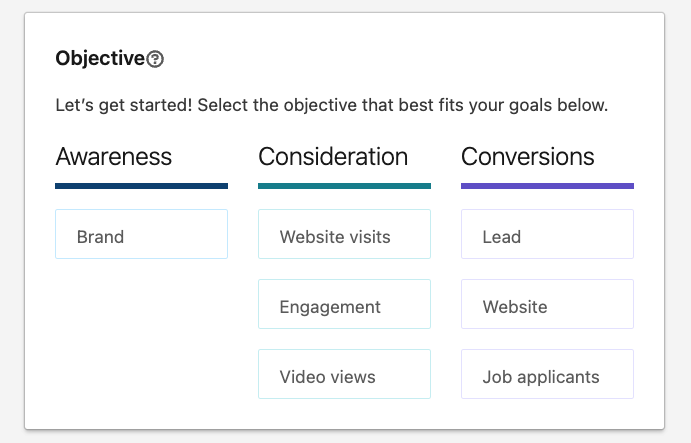
Which Campaign Objectives Should I Choose?
Each campaign objective should be selected carefully based on the specific goals of your marketing campaign.

1) Brand awareness
As the name implies, it’s best for top-of-the-funnel, awareness content. But there’s a catch.
You can optimize only for reach or impressions. And you will get a lot of reach and impressions—but at the cost of engagement.
Zero-click consumption means you’ll have a hard time building a retargeting audience. Which means you can’t follow up cold campaigns with retargeting layers. So it becomes a waste.
Optimizing for reach is only good when you have tens of thousands in ad budget and plenty of content.
If you can reach your entire audience with different content pieces multiple times retargeting can be an afterthought. Until then, optimizing for reach isn’t cost-efficient.
2) Website visits
Best used for cold campaigns or retargeting campaigns with no clear conversion action.
Always go for manual bidding unless your ads are time-sensitive (e.g. webinars). Start from a minimal bid—around 20% below the suggested range. Gradually increase it until you hit the sweet spot where you spend your full daily budget.
3) Engagement
No real benefit in using this objective. The engagement objective is only recommended if your goal is to grow your company page followers or increase social engagement on your ads.
The engagement objective will optimize toward any sort of action on your LinkedIn ad. That means a social action such as a like, comment, or share; a follow to your company page; a visit to your company page; and even a click to your call-to-action link.
4) Video Views
Video Views should be used for most video ads.
Video ads are terrible at driving traffic from LinkedIn. But they are great for in-feed consumption. You’ll get fewer clicks, but those clicks will be higher intent.
Play to the strengths of video ads and optimize for video views in most cases. If your goal is to drive website traffic, go with single image ads instead.
5) Website conversions
Best used for campaigns with a clear conversion action, i.e. lead generation.
LinkedIn doesn’t have powerful algorithms. Best case scenario we’ve only seen modest improvements in CPA compared to website visit optimization.
But an improvement is an improvement, so go for conversions whenever possible.
6) Lead generation
Best used when the goal is quantity over quality. This opens up LinkedIn native lead gen forms.
You’ll get accurate job titles and company data at a lower CPA. But the intent behind these leads is often lower.
It’s common to reach out and get a reply like “I don’t remember submitting anything.” The threshold for these forms is so low that people often forget they filled them out.
There’s nothing wrong with LinkedIn lead forms—they have their place. Just keep this limitation in mind.
The 7 LinkedIn Campaign Objectives
At present, the seven marketing campaign goals that LinkedIn can help with are as follows:
– Website visits
– Brand awareness
– Engagement
– Video views
– Lead Generation
– Website conversions
– Job applicants
It’s crucial to note before you begin your LinkedIn ad campaign that once you’ve chosen your LinkedIn campaign objective of focus and your campaign is live, you cannot then change it (the objective) later down the road. So, be sure that your objective is clear, realistic, and actionable.
So, without further ado, let’s delve into the seven LinkedIn campaign objectives and how to use them in your strategy.
Case Study: How We Helped a Security Analytics Software Company Generate 42% More SQLs Using LinkedIn Ads
Target 1: Website Visits

If your objective is to drive traffic to a website or landing page (on or off LinkedIn), here are your tools:
Ad Formats:
– Single image ad
– Carousel image ad
– Video ad
– Text ad
– Spotlight ad
– Message ad
– Conversation ad
– Event ad
Bid Types:
– Maximum delivery
– Target cost
– Manual bidding
LinkedIn is a wonderful resource for driving traffic because of the tools it uses to create an ad campaign that aims to get as many clicks as possible – because every click will take the user straight to your website/landing page.
How it works is LinkedIn’s algorithm will optimise the way your ad is presented for the purpose of driving traffic, instead of impressions (likes, shares, etc), and target the ad to the screens of users most likely to click on it, instead of just a generic LinkedIn audience.
How it does this is it pulls various user information, such as historical data, intent, and behaviour of users based on their interaction with previous content of a similar nature.
If your goal is to secure landing page clicks, it’s recommended to choose this manual bidding option, as it allows for more control over the results of your campaign.
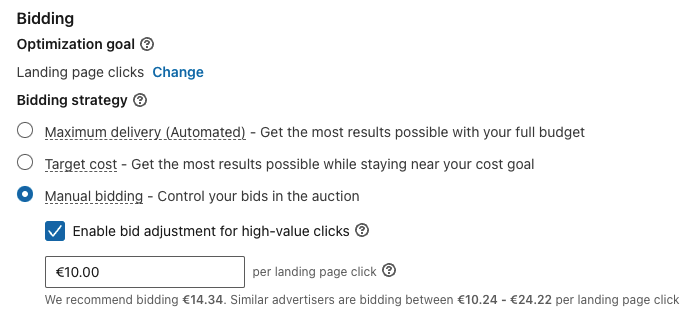
Expert Tip: If you want to send the users to a landing page or website in order to generate leads, you should choose “website visits” objective and avoid ” website conversions”.In most of the cases “website conversion” objective never outperform “website visits” objective because CPC and Cost per conversions are higher than website visits. Conversion data from Linkedin ads is not very accurate and they have a lack of volume. I think that’s the reason why LinkedIn ads is really bad with the conversions optimization.
Target 2: Brand Awareness

Ad Formats:
– Single image ad
– Carousel image ad
– Video ad
– Text ad
– Spotlight ad
– Follower ad
– Conversation ad
– Event ad
Bid Types:
– Maximum delivery
– Target cost
– Manual bidding
– Reach
Utilising LinkedIn campaign objective for brand awareness (particularly for B2B companies) can be an effective solution for both enhancing your chances of generating and converting leads, as well as building a robust business network.
If your ad campaign target is to draw more awareness to your brand, here’s what to consider when using LinkedIn:
– Create a campaign that aims for impression-gathering. And again, LinkedIn’s algorithm will accelerate the success of your campaign, because it will place it in front of users likely to view it, and it will base the number of potential views on the budget you’ve set for the campaign.

– Be clear that brand awareness alone is the goal here. Following the above method with hopes of brand awareness and, for example, conversions will not work. So make sure boosting your brand’s visibility is the one and only key focus here.
– Naturally, the best type of bidding for this campaign is “Maximum Delivery”, which is the default bid setting. Your “optimisation goal” should be set to “reach”. This setting will present your ad to as many targeted users as possible (in keeping with your budget limit, of course) and as many times as possible.

Expert Tip: If your goal is to get maximize exposure for your target audience without increasing website visits I recommend combining the “brand awareness” objective with the ” reach ” bidding optimization. You can also consider using the video format for your creatives, it’s a great way for building awareness and getting a stronger message if you don’t have a consistent landing page or website. If you want to get traffic on your website, use Website visits objective. CPC will be lower and you’ll get clicks as same cost.
Target 3: Engagement

Ad Formats:
– Single image ad
– Carousel image ad
– Video ad
– Follower ad
– Conversation ad
– Event ad
Bid Types:
– Maximum delivery
– Target cost
– Manual bidding
As the title suggests, this goal is to encourage users to interact with your campaign. If you select Engagement clicks, LinkedIn will try to deliver your ads to members who are most likely to interact with them.

LinkedIn user interactions include: like, share, comment, react, click, or company/user follow. LinkedIn’s data will be focussed on a user that is likely to interact based on his/her previous engagement activity.
Naturally, your post will (or should) have a CTA (call-to-action), but with LinkedIn, it’ll also display a “follow” button on the ad, giving you increased exposure and more opportunity to network.
It is worth factoring into your budget that you’ll also be charged for follows as well as generic engagements, so this may not be a viable option for those on a smaller budget.
Depending on what your LinkedIn Ads campaign objectives are, you may also find LinkedIn Follower Ads as another alternative objective for expanding your brand’s audience and building a bigger online network of potentially profitable leads.
Target 4: Video Views

Ad Formats:
– Video ad
Bid Types:
– Maximum delivery
– Target cost
– Manual bidding
Video is a powerful medium because it allows users to be spoon-fed information quicker and easier than they would by reading through paragraphs of text. And again, LinkedIn will target those prone to watching videos as their go-to method of media consumption.
Please note: with this method, an ‘ad view’ is not the same as a ‘video view’. Unless a user has clicked ‘play’, they are not considered an interactive user.
In terms of outcome, this is similar to brand awareness insofar as it’ll very likely create interaction and audience expansion, but not necessarily conversions.
In terms of bidding choices, it is wise to stick with ‘manual’ to maintain control over your budget. With video views, other options (particularly ‘automated’), you may find your budget spending becomes unmanageable or unsustainable. LinkedIn will provide counsel on what to do if your ad campaign is underperforming too.

Expert Tip: Videos views are the fastest and cheapest way to build a retargeting audience. Retargeting audiences based on video viewers can be collected more quickly than those based on website visits or engagement. They are much more effective than single image format campaigns. Not only faster but also less expensive because the cost per view is much cheaper than the cost per click for a single image.
Create a video that focuses on the problem/pain point your audience faces and the solution you offer. At this stage of the funnel don’t try to capture leads because your target audience doesn’t know you yet.
Target 5: Lead Generation

Ad Formats:
– Single image ad
– Carousel image ad
– Video ad
– Message ad
– Conversation ad
Bid Types:
– Maximum delivery
– Manual bidding
LinkedIn is an ideal platform for lead generation, and in terms of campaigns, often creates the best results. One of the reasons for this is that LinkedIn allows users to create a native Lead-Gen form to gather leads on LinkedIn. The idea is that the form will extract the information directly from the user’s profile, meaning he/she won’t have to take the time to manually fill it out, which can be time-consuming, and therefore off-putting to a potential lead. Because of this, there will be increased form submissions and a reduction in cost-per-lead fees.
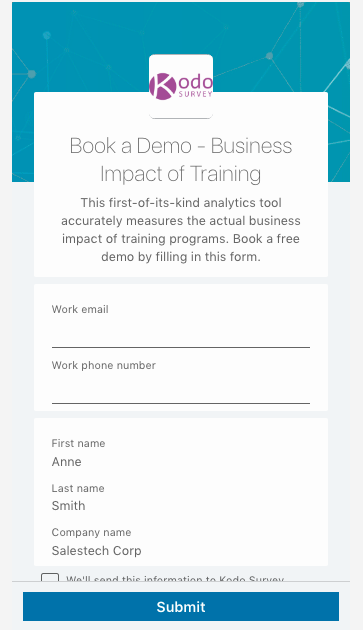
In terms of bidding options, You can select between generating the most leads as possible, getting the most clicks, or driving the most impressions with your ads.
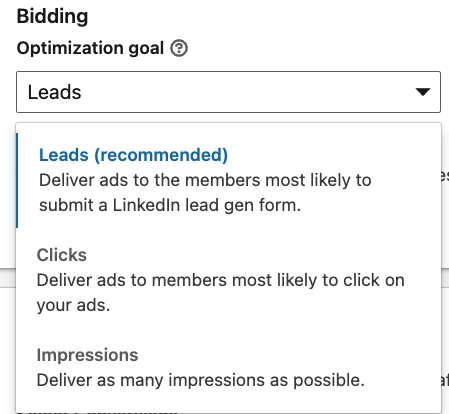
Expert Tip: Although our agency always AB test both objectives (Lead gen form vs website visits), in general a lead gen form campaign is going to beat website visits objectives most of the time since the conversion rate for a lead gen form is 30-40% higher. Lead gen forms make logically the conversion easier than a landing page (seamless experience and pre-filled field). Also, it’s faster for a user to fill a lead gen form than be redirected to a landing page.
Target 6: Website Conversions

Ad Formats:
– Single image ad
– Carousel image ad
– Video ad
– Text ad
– Spotlight ad
– Message ad
– Conversation ad
Bid Types:
– Maximum delivery
– Manual bidding
Web conversion campaigns are similar to the above lead conversion objective, with the only difference being that this tactic directs users away from LinkedIn and onto your website. Whether or not you wish to convert them once they land on your homepage is up to you.
It is important that you set up LinkedIn Conversion Tracking first before proceeding with this campaign objective. This tool will provide data on the actions of users once they land on your website homepage, which can be paramount for future marketing, as well as your web design.
Your LinkedIn default optimisation setting will be “website conversions”, and the bidding type that’s recommended here is “Maximum Bidding”. As with the other LinkedIn campaign objectives, the amount of website conversions will be influenced by your budget.
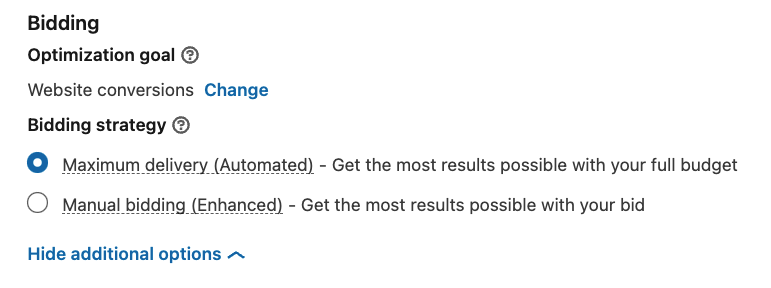
Expert Tip: Never use ” website conversions” as objective for Linkedin ads, especially if you don’t already have an account with tons of conversions. Your cost per click and cost per conversion will likely be much higher on website conversions than it would be for just traditional website visits objective.
Target 7: Job Applicants

Ad Formats:
– Single job ad
– Jobs ad
– Single image ad
– Spotlight ad
Bid Types:
– Maximum delivery
– Manual bidding
Last but not least, our final LinkedIn campaign objective is seeking job applicants. LinkedIn is better-suited to this target than any other social media platform, owing to its professional networking prowess, and that it offers more demographic information in comparison to channels such as Facebook or Twitter.
When advertising a job through a campaign, this LinkedIn campaign objective will allow you to do so through three different ad formats: ‘Jobs’, ‘Spotlight’, and ‘Sponsored Content’ (single image ad).
Selecting ‘Jobs’ will divert users to the ‘Job Offers’ section of your company’s LinkedIn page. Please note, however, it will not take the user to the specific position.
If you choose ‘Spotlight’ or ‘Sponsored Content’ you’ll be able to create standard LinkedIn jobs with a custom URL. Naturally, the optimisation goal here is ‘landing page clicks’.
Either bidding tactic will be suitable. However, if your budget is on the smaller side, consider sticking with ‘manual bidding’ to better control your budget.

Conclusion
So, as you can see, LinkedIn ad is a powerful tool for both marketing and recruitment alike, and its software and algorithm will aid your ad campaign every step of the way – providing you choose the best ad format and bidding options based on your campaign objectives and your budget.
If you’d like to learn more about how we help B2B SaaS and Tech companies grow their MRR through LinkedIn advertising, contact us online or send us an email today at info@getuplead.com to speak with someone on our team.
You might also be interested:
- LinkedIn Retargeting: How It Works & How to Set It Up
- LinkedIn Ads Targeting Options: The Complete Guide
- How to add a User to LinkedIn Campaign Manager?
- A Complete Guide to LinkedIn Tracking for Beginners
- Linkedin Bidding Strategies: The Complete Guide
- LinkedIn Ad Optimization: Tips and Best Practices


